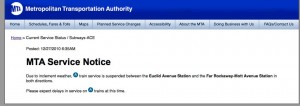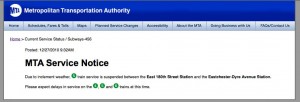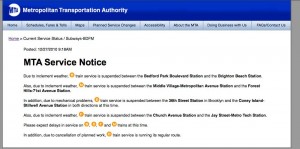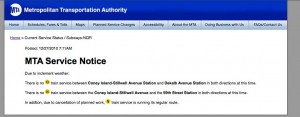For anyone that might not understand why some subway lines run in the snow, while others do not, consistently year after year, here’s a mini guide with explanations that the MTA never seems to want to admit to.
Let’s take this Line by Line with 4 samplings of major routes.
The A Train:

The A of course is not running south of Euclid Ave, with the already famous horror story of the one train that was stuck in the snow all night.
Explanation: The A line is above ground after Euclid Ave – first on an elevated line then on the surface (old LIRR Rockaway branch) out over Jamaica bay. Any subway line running on flat on the ground in a blizzard will soon shut down. The third rail will be buried. No power, no trains. On the Rockaway side, the subway line is elevated again- though it is not a traditional elevated subway line. It’s a solid viaduct where snow can accumulate and bury the third rail – unlike the other elevated lines in the system where the tracks sit on beams and the snow falls through.
The 4.5.6 Lines:

Explanation: The 4 and 6 lines only run either in tunnels (where no large amount of snow can get in) or elevated lines, where the snow simply falls between the tracks to the streets below and rarely gets a chance to cover the third rail.
The 5 though, runs on the surface (along the route of the old NYW&B RR) in the northern Bronx, and thus will always be shut down in a major snow storm. Third rail buried, no power, no trains. Done.
The BDFM:

Explanation: The D runs in a cut below street level around the 9th ave station in Brooklyn, thus it’s no surprise that this line is prone to getting shut down. The B (and the Q) run through the ‘brighton beach’ line in Brooklyn, which is also a ‘cut’ below the streets, yet open to the air and elements. It’s the perfect ditch to get snowed in. It doesn’t take much for the snow to go over the 3rd rail here.
The M line near fresh pond is on the surface, and thus prone to 3rd rail burial. You’ll note service ended where the elevated line begins.
As for the F, the viaduct around Smith / 9 is solid, much like the A line in Rockaway. Without holes for the snow to fall through, burial happens.
And lastly, the N and Q lines:

Explanation: Both of these lines run in ‘cuts’ in Brooklyn. Ditches where snow gathers fast. Both lines always shut down in the snow. On the Queens end, they’re on an el, and through Manhattan in tunnels. The R rarely shuts down in the snow, because it’s in a tunnel the entire length of it’s run. Same goes for the E and a few other lines.
Variety of subway line types
By now you might wonder, why the hell were some subway lines built in ‘cuts’, others on elevated lines, and still others in tunnels and flat on the surface. The reason of course is hinted at above- all of these lines were build by different companies, none of which I’d imagine gave much thought to how nature might effect day to day operations of each.
As you can gather from the above. There should never be any surprise what subway lines will shut down in the snow. When you look at the physical characteristics of where each subway runs, it’s pretty obvious what to expect.
Of course, what has made the 2010 storm worse is the fact that it happened right after a holiday when most people were off, and even if they wanted to, a lot of workers couldn’t even make it in to clean up the mess. But that’s fodder for some other blog post..
Leave a Reply